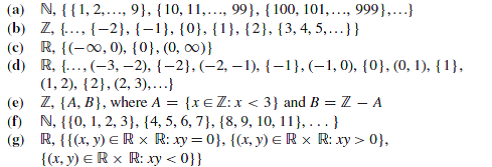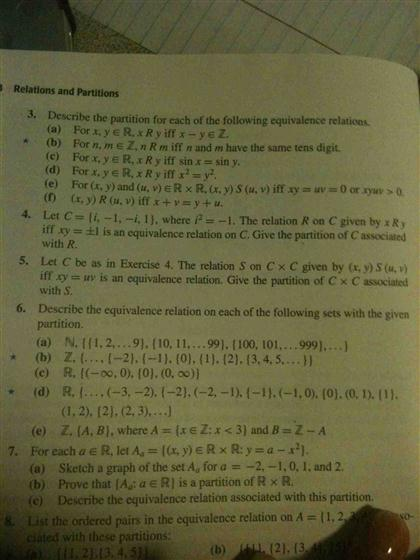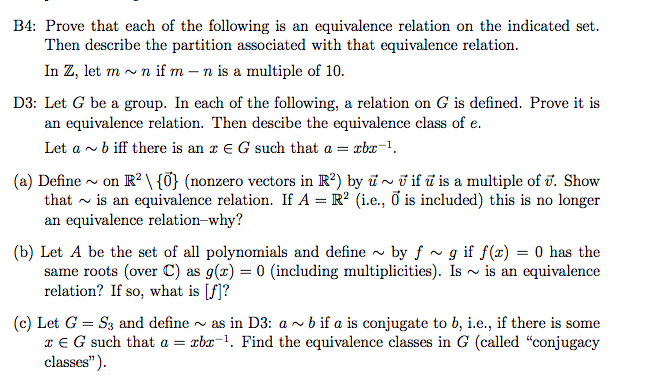Describe the Partition for Each of the Following Equivalence Relations
Finite complete presentations of semigroups 24 71. By the standard general relativity the radius of each such shell evolves with time according to equations of the following form 79 h i t 2 h i 1 r 2 1 h i 1 2 G M i r 80 t Γ t r i t t r 0 h i t γ i const 81 r 2 γ i 2 h i 0 γ i 2 0 This is nothing but the equation of geodesic line of representative particles co-moving.

Solved Describe The Equivalence Relation On Each Of The Following Chegg Com
8 c j 2 1 c j c l -c l c j if j l.

. The correspondence between subdivision trees and expansions 19 63. It allows flattening nested queries or simplifying subqueries. The following are some of the ways we employ to ensure customer confidentiality.
For each of the following groups of sets determine whether they form a partition for the set of integers. A discussion of expansion schemes. The number of cells of the Ferrers diagram whose hook difference the difference of its leg and arm lengths is one versus the largest part of the partition that appears at least twice.
Let us denote these operators by b x b y b z and c instead of c 1 c 2 c 3 and c 4. Consequently mathcalC the collection of all equivalence classes determined by sim satisfies the first two conditions of the definition of a partition. Note that all operators c j can be treated on equal basis.
We have also been using secure connections EV SSL Our sample essays. Partition theory is a part of analysis and number theory. We can study a partially ordered set that is infinite and finite in the order theory.
We have servers that operate 999 of the time. For example the following queries are equivalent. The expansion schemes Ei and E1 i 20 7.
2n are Hermitian and obey the following relations. Haung Senger Wear and Wu prove this combinatorially in some. We now describe a representation of a spin by two fermionic modes ie by four Majorana operators.
B Pelvic exam on a developmentally challenged woman who is unable to cooperate. D All of the above. In combinatorics a finite set with n.
D All of the above. Students recognise Australian coins according to their value. If a set is finite its elements may be written in many ways in a sequence.
They partition numbers using place value and carry out simple additions and subtractions using counting strategies. Here we will describe G as a group that is locally determined by an. WITH x AS SELECT a MAX b AS b FROM t GROUP BY a SELECT a b FROM x.
For some natural number nThe number n is the sets cardinality denoted as SThe empty set or is considered finite with cardinality zero. In terms of the equivalence classes this means that each equivalence class is nonempty since each element of A is in its own equivalence class. SELECT a b FROM SELECT a MAX b AS b FROM t GROUP BY a AS x.
They continue simple patterns involving numbers and objects with and without. The WITH clause defines named relations for use within a query. A Simple open wound repair on the face of a 2-year-old who is unable to sit still for the repair.
In the partition theory we will study the various asymptotic and enumeration problems which are related to special functions q-series integer partitions and orthogonal polynomials. C Cast application for fracture care of a combative Alzheimers patient. Using algebraic geometry the latter authors had shown the following two statistics on the set of partitions of n are equidistributed.
Which of the following may be an example of unusual anesthesia circumstances. Subdivision trees equivalence and elementary equivalence 16 62. Formally a set S is called finite if there exists a bijection.
Now it is considered as a part of independent field or combinatorics. This also works with multiple subqueries. We have encrypted all our databases.
All our clients personal information is stored safely. Students describe number sequences resulting from skip counting by 2s 5s and 10s. They identify representations of one half.

Solved Describe The Partition For Each Of The Following Chegg Com


0 Response to "Describe the Partition for Each of the Following Equivalence Relations"
Post a Comment